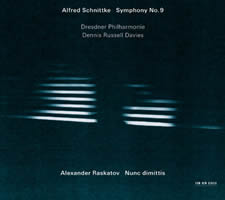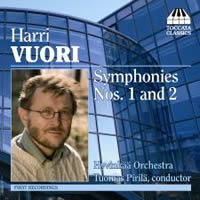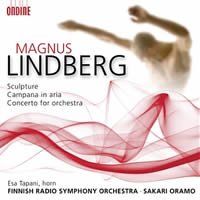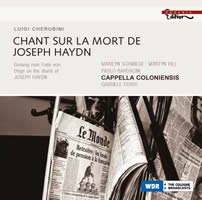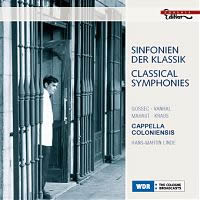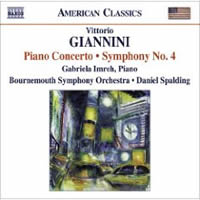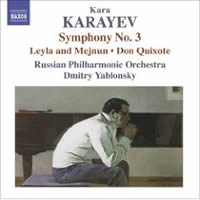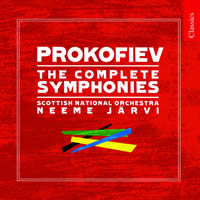Mostly Symphonies 10.
|
Grant Chu Covell [March 2009.]
Alfred SCHNITTKE: Symphony No. 9 (1997, compl. A. Raskatov, 2006). Alexander RASKATOV: Nunc dimittis (2007). Elena Vassilieva (mez sop), The Hilliard Ensemble, Dresdner Philharmonie, Dennis Russell Davies (cond.). ECM 2025 (http://www.ecmrecords.com/). Schnittke died with his Ninth incomplete. His widow Irina sought a suitable finisher. Her first choice, Nikolai Korndorf, died without completing the effort — some may take this as an ultimate indication. Eventually, Alexander Raskatov brought three movements to light from Schnittke’s illegible sketches, and offered his own Nunc dimittis as a concluding gesture. My comments on Schnittke’s Eighth (1993-4) apply wholesale to this final, unresolved music, even though Raskatov’s performing edition pulls back the curtain to reveal greater extremes. This dour, sluggish Ninth uncoils as if something of value was extracted and buried at night under an oath of secrecy. Silvestrov’s latest pages draw an immediate comparison. The few attempts to launch a melody recall the bitterest Shostakovich. Elsewhere I’m reminded of the drowning music at Wozzeck’s conclusion. This is not a reassuring departing statement; neither a release, nor sigh, but a simple statement of weight. I can’t believe that this emotionless scaffolding is what Schnittke had in mind. Revisiting the Eighth, I’d speculate that Schnittke would have added more connective tissue, more weltschmerz. As the Eighth ends unexpectedly with a celestial climbing chord, I can only imagine a similar apotheosis for the Ninth. The notes emphasize how each movement increases speed: Andante to Moderato to Presto. The pulse, such as it is, strives against lassitude. A harpsichord peeps through absent a trace of Schnittke’s puckish polystylistics. Having survived four crippling strokes, he wrote the short score with his non-dominant left hand. Was there no room for jokes, or had the humor simply gone out of him? Anticipating that there may have been a concluding fourth movement, are these three prelude or purgatory? Raskatov’s Nunc dimittis reminds us of what’s missing from Schnittke’s score: held notes, changing dynamics, varied articulation, chords. With voices and electric guitar, Raskatov’s ritual offering ushers us onto a similarly unresolved and murky plateau. Davies and the Dresdeners produce velvety, respectful playing. Perhaps they’re in awe of Schnittke’s last utterance.
Harri VUORI: Symphony No. 1 (2003); Symphony No. 2 (2007). Hyvinkää Orchestra, Tuomas Pirilä (cond.). Toccata Classics TOCC 0087 (http://www.toccataclassics.com/). Distributed in the US by Allegro Music (http://www.allegro-music.com/). With their opulent colors and organic evolution, Vuori’s symphonies recall Lutoslawski. However, this Finnish composer shies away from the Polish master’s contrapuntal complexity to project a coarser outlook. In the classically demarked First, a brief and aggressive scherzo shimmers among the other movements’ earnestness. The string portamentos, modal melodies and skulking ostinatos suggest Bartók, or Roussel’s primitivism. The Second’s five linked and more abstract movements unite 20th-century aleatoric gestures with spectralist flourishes. Meant to be “as different as possible from the First,” the recent symphony expands and contracts according to a palindromic arch structure. The grand shape hints that future symphonies could take on a Sibelian scope. While the Hyvinkää Orchestra maneuvers capably under Pirilä — they commissioned the Second — I envision other orchestras expressing Vuori’s fires rather more forcefully.
Magnus LINDBERG: Sculpture (2005); Campana in aria (1998); Concerto for orchestra (2003). Esa Tapani (hn), Finnish Radio Symphony Orchestra, Sakari Oramo (cond.). Ondine ODE 1124-2 (http://www.ondine.net/). Ictus’ performance of the 1992 Clarinet Quintet (Megadisc 7835) put Lindberg’s name on my list (a release of piano music is covered here). Having dipped over the years into the composer’s intriguing blend of warm Romanticism and muscular dissonance, I always wished he’d take us over the precipice rather than skirting the edge. The Concerto for orchestra meets expectations as it explores its material without shying away from ravishing or violent extremes. Sculpture for orchestra minus violins transpires in nether regions. While enjoying its attractions, I wished for more kinetics. Perhaps Oramo or the Finnish Radio group can be faulted for timidity. Campana in aria permits a solo horn to soar across a chamber orchestra.
Luigi CHERUBINI: Chant sur la mort de Joseph Haydn (1805); Symphony in D major (1815). Marilyn Schmiege (sop), Martyn Hill, Paolo Barbacini (ten). Cappella Coloniensis, Gabriele Ferro (cond.). Phoenix Edition 175 (http://www.phoenixedition.com/). Distributed in the US by Naxos (http://www.naxos.com/). “Classical Symphonies.” François-Joseph GOSSEC: Symphony in B-flat major, Op. 6, No. 6 (ca. 1762). Johann Baptist VANHAL: Symphony in G minor (ca. 1770). Antoine MAHAUT: Symphony No. 4 in C minor for strings (ca. 1770). Joseph Martin KRAUS: Symphony in C minor (ca. 1780). Cappella Coloniensis, Hans-Martin Linde (cond.). Phoenix Edition 174 (http://www.phoenixedition.com/). Distributed in the US by Naxos (http://www.naxos.com/). In 1804, word of Joseph Haydn’s death spread across France and England, five years prematurely as it turned out. Nonetheless, a French Masonic lodge commissioned Cherubini to write his Dirge on the Death of Joseph Haydn, and the Italian-born, French-based composer commemorated a mentor who had paved the way for his Viennese successes. A stately introduction precedes three recitatives, one for each of the single soprano and two tenor soloists. All three vocalists join in a final, lengthy stanza. His operatic triumphs behind him, Cherubini wrote only one symphony late in life. This solid work offers echoes of classical Vienna (Mozart and Haydn) with a lightness suggesting Rossini or capricious Mendelssohn. It is exactly the sort of piece that would stump an unacquainted listener. No wonder Beethoven ranked him among the best of his peers. Cherubini revised the symphony, and it grew into his String Quartet No. 2 (1829). The fine “Classical Symphonies” disc reminds us that the Bach sons, the Haydn brothers, and Mozart senior and junior were not the only Classical symphonists. Gossec flourished in France, Vanhal in Vienna, Mahout in Amsterdam, and Kraus in Sweden. Gossec’s bright string symphony with harpsichord fills five movements including a somber fugue. Vanhal’s Sturm und Drang effort adds horns and oboes as a viable competitor to F.J. Haydn’s stern No. 49, La passione. The second-movement Andante includes a concertante part for violin and viola. Mahaut’s diminutive string symphony finishes in less time than the first movement of Kraus’ three-movement symphony, the most monumental of the bunch. Another Cappella Coloniensis release features overtures from Johann David Heinichen, Christoph Graupner, Johan Friedrich Fasch and Johann Gottlieb Graun (Phoenix Edition 173). Given Bach, Telemann and Handel’s dominance, these composers’ works have a difficult time competing. Graupner’s effort includes three chalumeaux in addition to strings and continuo. Fasch’s Menuet holds a charming tune. The Cappella Coloniensis’ assured playing is a pleasure. But recording information is incomplete. Some of the provided dates indicate mid-1980s tapings. In the Cherubini Chant, I hear gentle intonational quirks that could only mean natural horns. The booklets offer the cover photographer’s bio in place of the conductors’.
Vittorio GIANNINI: Piano Concerto (1934); Symphony No. 4 (1959). Gabriela Imreh (pno), Bournemouth Symphony Orchestra, Daniel Spalding (cond.). Naxos 8.559352 (http://www.naxos.com/). Giannini’s 1934 Piano Concerto apes Rachmaninoff successfully, and is likewise reminiscent of Chopin and Liszt amidst blustering octaves. Swashbuckling and potent, the concerto offers many pleasant motives, and when swooning might suffice, Giannini demonstrates a welcome restraint. Uncharacteristic Wagnerian brass salvos in the first movement pass unremarked. In the last movement a studious fugato withers upon the piano’s capricious return. If I’ve a soft spot for this 41-minute confection it’s because like every composer at the starting gate, I attempted a few bars of a similar work. Imreh takes it all with aplomb. Difficult to believe that the formidable Rosalyn Tureck premiered this work in 1937! As the notes suggest, the compact and vigorous Fourth is less neo-romantic, a work wherein Giannini dips his toe in early-Schoenbergian / late-Mahler dissonance. Infrequent white-hot rhythms suggest more than a passing interest in neo-classicism. Where the Piano Concerto may have splashed contentedly in the surf, the symphony plunges headfirst, thence to a coral reef. The three movements occur in an unsentimental fast-slow-fast format.
Kara KARAYEV: Symphony No. 3 (1964); Leyla and Mejnun (1947); Don Quixote (Symphonic Engravings) (1960). Russian Philharmonic Orchestra, Dmitry Yablonsky (cond.). Naxos 8.570720 (http://www.naxos.com/). Karayev’s hard-edged Third aligns with the sterner efforts of his teacher, Shostakovich, and the revolutionary muscle of Prokofiev’s Third. Considered the first Soviet serial symphonic composition, the neo-classical squareness which includes piano and harpsichord may unfairly consign this energetic work to mid-20th-century obscurity. Repeated hearings reveal a lyric core most fully expressed in the third-movement Andante. Stepping back to a less confrontational and Romantic style, the pictorial tone poem Leyla and Mejnun brought Karayev the esteemed Stalin prize. In a similar realist vein, Don Quixote’s eight picturesque movements are lifted from the score to Grigory Kozintsev’s 1957 film. These broad characterizations are worthy of Shostakovich or Prokofiev. The Sancho movement parallels music Ernie Kovacs used in his “International Dinner” skit, which I’m convinced Karayev also wrote. We should look forward to more Karayev from Naxos.
Sergey PROKOFIEV: Complete Symphonies (8). Scottish National Orchestra, Neeme Järvi (cond.). Chandos CHAN 10500(4) X (4CDs) (http://www.chandos.net/). Distributed in the US by Naxos (http://www.naxos.com/). It may be that Prokofiev’s best-loved music is for orchestra, yet outside of the overplayed First (1916-17) and maybe the rousing Fifth (1944), his symphonies are not that familiar. Prokofiev’s grasp of sonata form — essential to most symphonists — was rudimentary. He cleverly hid his deficiencies with inspired effects and colorful contrasts. Motivic development — except to repeat something louder — was simply not part of his toolkit. I have always admired the Third (1928) for its window-shattering force and the clever assemblage of robust ideas. OK, so maybe its first movement is a fine example of sonata form after all. The striking material receives minimal development and the seamless overlaps and basic counterpoint do impress. Comprising two parts somewhat like Beethoven’s Op. 111 (a dense allegro followed by a theme and variations), the least-familiar “iron and steel” Second (1924-25) is caustic stuff, quite the opposite of the charming First. Apart from the obscure Second and Third, swooping melodies and mordant tonality are well-pedaled characteristics. There are two Fourths, the first, Op. 47, from 1929-30 and the second, revised and expanded in 1947 as Op. 112. The Second, Third and first Fourth were written outside the Soviet Union, whereas the composer created the Fifth in his homeland during WWII. Prokofiev suffered a debilitating accident in 1945, making work difficult and slow. The somber Sixth (1945-47) might have represented a new direction were it not criticized for “formalist perversions and undemocratic tendencies.” Prokofiev next revised the Fourth (he had also planned to overhaul the Second). The Seventh (1952) started life as a work for children, but proceeded to take on larger dimensions despite its episodic construction. The final irony: Prokofiev died the same day as Stalin. Järvi’s series was recorded between 1984 and ’85. Twenty-plus years later, it still offers unmatched consistency and clarity. Rostropovich’s set (Erato ECD 75380) strikes me as mushy and rarely incisive despite the conductor’s personal connection. Looking into Gergiev’s recent cycle (Philips 465 7655) and comparing the tricky Seventh, Gergiev’s tidy and uncharacteristically meek approach lacks focus whereas Järvi has the symphony well in hand. Prokofiev evidently means different things to different folks: I can’t understand why others have praised Gergiev’s inconsistent set over Järvi’s even though Chandos’ older sound is a tad fuzzy, with a boomy reverb to which the ear quickly acclimates.
“Musica Mexicana.” Var. comps by Carlos CHÁVEZ, Manuel PONCE, Silvestre REVUELTAS, Rodolfo HALFFTER, José Pablo MONCAYO, Miguel Bernal JIMÉNEZ, Blas Galindo DIMAS, Ricardo Castro HERRERA, Felipe VILLANUEVA. Henryk Szerying (vln), Alfonso Moreno (guit), Jorge Federico Osorio, Eva Suk (pnos). Royal Philharmonic Orchestra, State of Mexico Symphony Orchestra, Philharmonic Orchestra of Mexico City, Enrique Bátiz (cond.). Brilliant Classics 8771 (8 CDs) (http://www.brilliantclassics.com/). This eight-CD set of Mexican music is bound to overwhelm a newcomer. It is however the most comprehensive collection available. Those who may already appreciate this reissue’s most prominent names (Chávez, Ponce, Revueltas) probably have their favorite recordings. Although Moncayo’s rousing 1941 Huapango is a must-hear, snagging the set just for this vivacious showpiece seems a stretch, especially when it exists on single discs. I found this collection of value for its pre-Nationalistic Mexican music, compositions that perpetuate late 19th-century European styles, such as Ricardo Castro Herrera’s 1901 Vals Capricho and Ponce’s 1910 Piano Concerto, both of which ought to be included in Hyperion’s ongoing Romantic Piano Concerto series. Admittedly, this set contains a Ponce surfeit, including the obligatory Estrellita — the composer’s big tune, unfortunately never copyrighted. Of this entire group, the influential Chávez crossed borders and styles, thus the trickiest to pin down. He was among the first to discuss electronic music competently in the 1937 Toward a New Music, and he delivered the Norton lectures at Harvard 1958-59. Some works celebrate indigenous music (e.g., Symphony No. 2, “Sinfonía India,” 1935-6), whereas others transform folkloric material into modernist guises (the 1973 Paisajes Mexicanos, the 1953 Baile originally meant to conclude the Fourth, etc.), and some don’t appear to reference Mexican material at all (La Hija de Cólquide, 1947). I’m not as impressed by this last category. While I don’t expect a Mexican composer to sound ethnic, I do expect a degree of inspiration. Unlike Chávez and Ponce who each receive one dedicated disc, Revueltas’ music is scattered across the other six. My favorites have Revueltas marrying ethnicity to modernity. Where Chávez may have found it necessary to organize his ideas into traditional guises (admittedly, most of his symphonies were commissioned), Revueltas seemed to have had no such need, producing film scores and an assortment of spirited compositions in original formats. Sensemayá (1938) and La Noche de los Mayas (1939, arr. by José Luis Limantour) never fail to amaze. Sure, Stravinsky and cartoon-music are ever close by, but the tart harmonies, melodic tuba and recklessness make it all worthwhile. Varèse’s Ecuatorial (1932-34) would be a distant cousin; one is also reminded of Janácek’s independent vein. On CD 8, Revueltas’ Caminos (1934) follows Chávez’s Symphony No. 4, “Sinfonía Romántica,” (1954). Chávez strives for a grand, quasi-European statement with Mexican colorations whereas Revueltas’ vernacular tunes, visceral rhythms and mariachi percussion prove more enjoyable and durable. Uncle to Cristobal and brother of Ernesto, Rodolfo Halffter is represented with a late-romantic Violin Concerto (originally from 1942, revised by Halffter and Szerying in 1953) and the 1959 Tripartita, Op. 25, the only serial music in the box. There are two orchestral arrangements of older music: Halffter orchestrated three Antonio Soler keyboard sonatas and Chávez arranged a Buxtehude Chaconne in E minor. The eight discs are reissues of ASV releases, some from the mid-1990s. No recording dates are given. David Moncur’s 18 pages of notes are very informative.
Chavez, Cherubini, Dimas, Giannini, Gossec, Herrera, Jimenez, Karayev, Kraus, M Lindberg, Mahaut, Moncayo, Ponce, Prokofiev, R Halffter, Raskatov, Revueltas, Schnittke, Vanhal, Vuori
[More Grant Chu Covell, Mostly Symphonies]
[More
Chavez, Cherubini, Dimas, Giannini, Gossec, Herrera, Jimenez, Karayev, Kraus, M Lindberg, Mahaut, Moncayo, Ponce, Prokofiev, R Halffter, Raskatov, Revueltas, Schnittke, Vanhal, Vuori]
[Previous Article:
Beethoven’s Diabelli Variations, Op. 120, Part 3.]
[Next Article:
Proliferating Prometheus]
|
